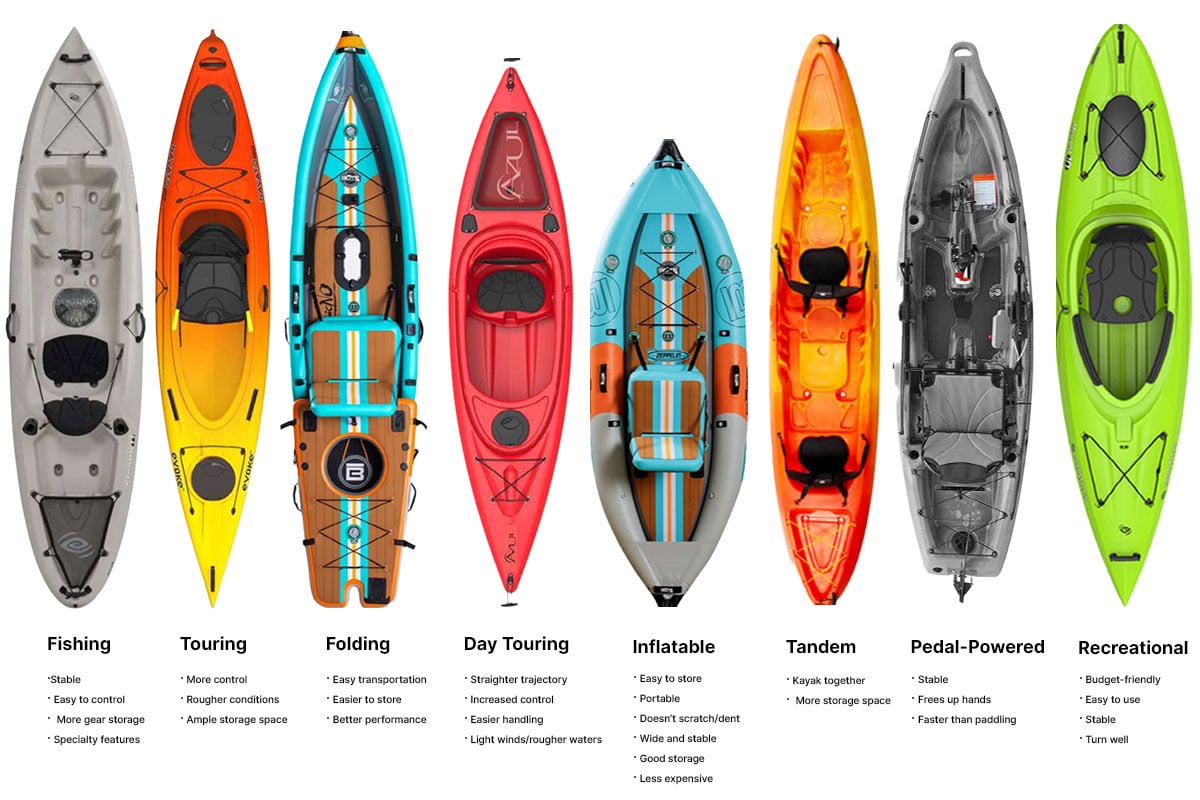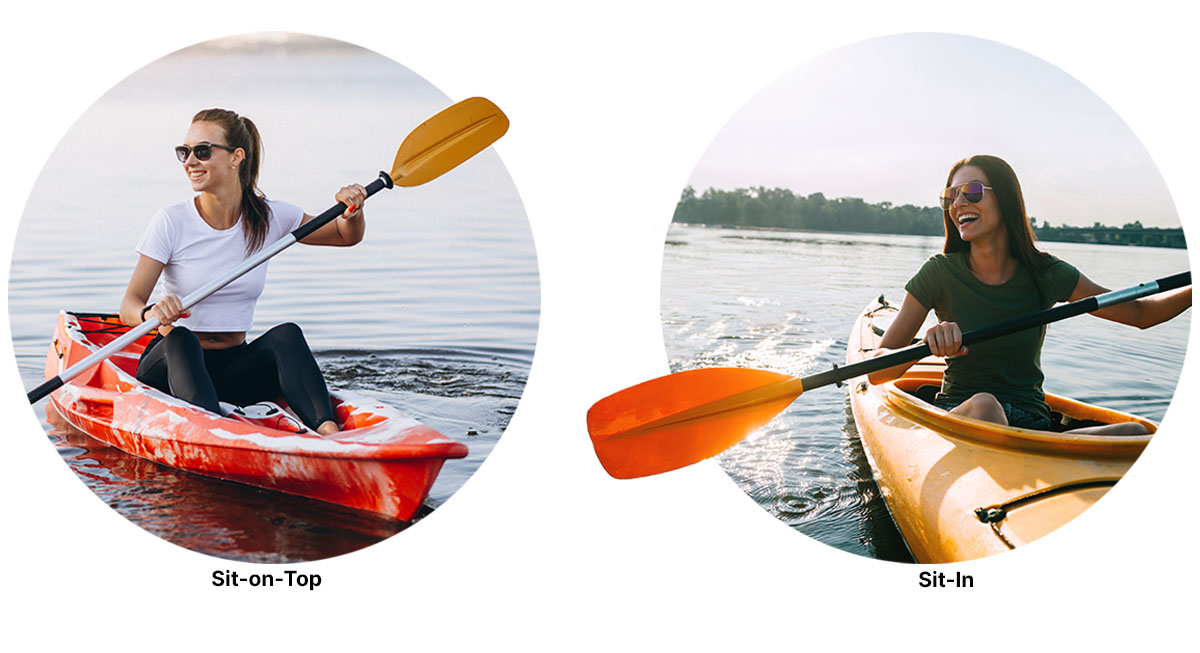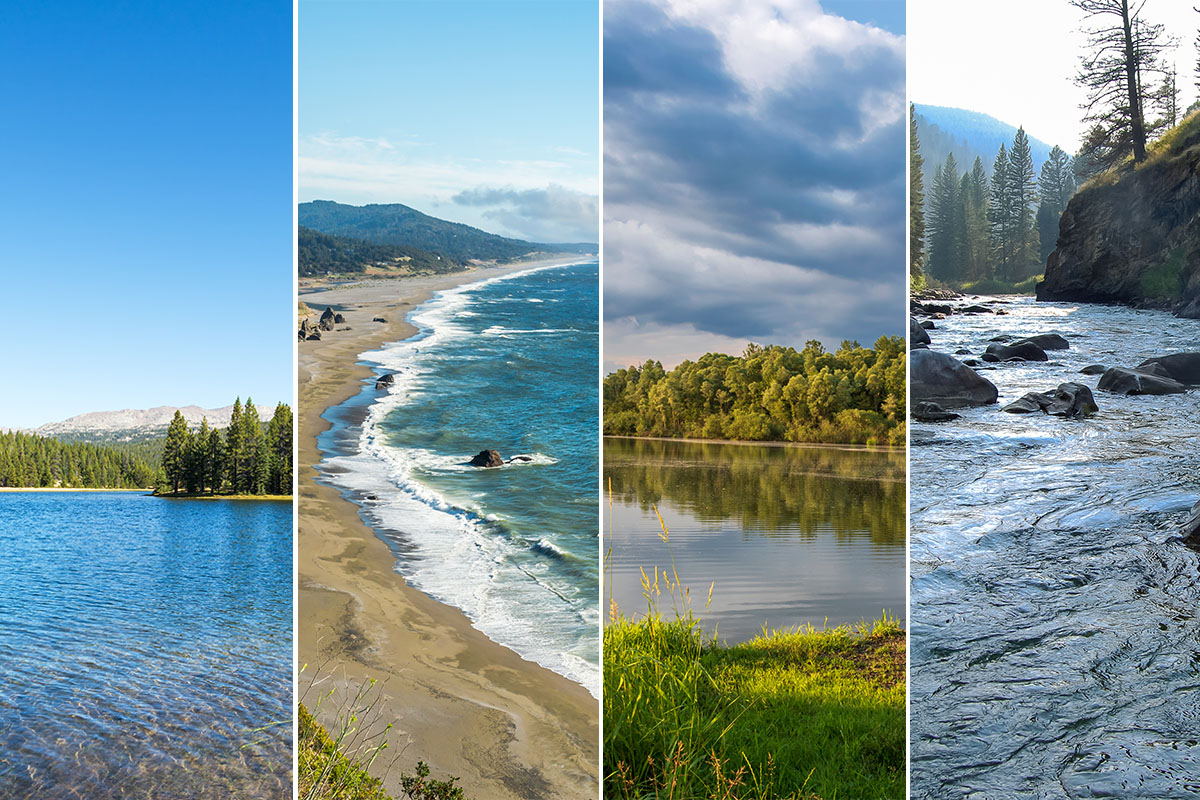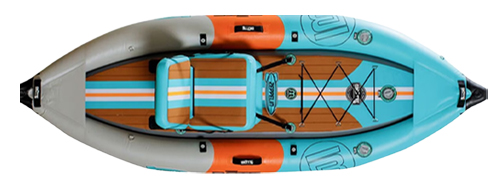How to Pick the Best Type
of Kayak for You [Full Guide]

Kayaking is a broad sport, there are plenty of different types, and one kayak certainly does not fit all in this world. You can be a hard core white water rafter, a recreational kayaker at the local lake, or anything in between. The only thing I know for sure is that whatever you plan on doing with your kayak, it's going to be fun! To make sure it is as fun and efficient as possible, you need the right kind of kayak for activity, which isn’t always so easy to figure out.
Today I plan on simplifying that decision making process, and making you more confident in your choice. We will look at a few of the most important questions first, like if you want a sit on or sit in kayak, and what type of water you plan to use it in. To wrap it up, we will look at some specific types of kayaks, and highlight some of the more specific details you may want to know before you checkout. If you already know what section you want, click one of the links below to jump right to it!
- Sit-on-top or sit-in kayaks
- Types of kayaks
- Which kayak is best for lakes, oceans, or rivers?
- What material is best for a kayak?
- What type of kayak hull do I need?
- What else do I need to buy a kayak?
If you are a little overwhelmed at all the options and different kinds of kayaks you have seen in stores, don’t worry, we are going to narrow down your search pretty quickly. Let's get started with the largest thing we could filter for, sit-in vs sit-on-top kayaks.
Sit-on-top or sit-in kayaks?

The first major distinction you're likely to notice when watching kayakers paddle by is how they're sitting. They'll either sit on top of the kayak, giving a more raised position or sit in the kayak so your body is more in line with the water level.
Sit-on-top kayaks are easy to get into and out of, which can be soothing for those newer to kayaking or nervous about a capsize. You're likelier to get wet in a sit-on-top kayak, so they're better for warmer waters. They often have good storage space, stash spots, and scupper holes to drain on their own. They are heavier than most sit-in kayaks and are primarily intended for recreational use.
Sit-in kayaks can be recreational or used for touring and day touring. They are faster, more efficient boats, and because your body intersects with the kayak in more places, the paddler can better control the kayak's trajectory. They are more difficult to get out of, and kayakers must know how to do a "wet exit" if a capsize occurs. Their storage compartments are covered but not self-draining, so you'll need to pump water out if the kayak gets flooded.
| Sit-on-top kayak | Sit-in kayak |
|
|
Which kayak is best for lakes, oceans, or rivers?

Before we dive into the types of kayaks, you might notice that a body of water doesn't usually categorize them. Still, the type of water you plan to use your kayak in does impact what type of kayak you'll ultimately want, so it's important to take a moment to understand the differences.
Coastline. If you are heading out into the choppier waters of a nearby coast, you'll want the added control of a sit-in touring kayak. A rudder and fixed tracking fin or a dropdown fin will help you navigate the various winds and currents you'll be dealing with. A sit-on-top might work fine, but be prepared to get wet!
Ponds and small lakes. Recreational kayaks do well in smaller, nearby lakes. The key here is to watch out for big waves with whitecaps – if you see these in the lake you're targeting, a recreational kayak may not quite cut it. But a sit-in or sit-on-top recreational kayak will do nicely if you're heading to the local lake.
Slow moving rivers. Whitewater rafting deserves its own article – but it's important to prioritize your boat's ability to turn for a basic trip down a river. A shorter recreational kayak or a day touring kayak will work well for these purposes.
Still & moving water. If you plan on exploring rivers and lakes, you can find crossover boats that serve both purposes. A dropdown fin (called a skeg) is helpful here, as you can move it in or out of the water depending on whether you want to prioritize turning easily or tracking well. A shorter kayak with a rudder can also work for these purposes.
| Body of Water | Best Type of Kayak |
|---|---|
| Coasts |
|
| Still Lakes |
|
| Rivers |
|
| Crossover |
|
Types of kayaks
Now we're ready to dive into the types of kayaks! These categories are not always clear-cut – it's important to look at the boat's features and the basic terms the manufacturer uses to describe it. But these basic types will get you started finding the right boat for your needs.
1. Recreational kayaks
Recreational kayaks are available as both sit-in and sit-on-top. These kayaks are both budget-friendly and easy to use, making them a great fit for casual and beginning kayakers. They're stable, turn well, and are easy to get in and out of. You'll have a bit of storage for essentials, but likely not an overnight trip.

These kayaks don't track as well as some more complex models, meaning they have more trouble moving in a straight line and can be blown off course more easily. For this reason, they are better suited for mild conditions and shorter distances. More sheltered waters like easy rivers and still lakes are the ideal spots for recreational kayaks.
Recreational kayaks are typically 8’-12' long. They can come in individual or tandem models, with different options for storage hatches. They are also wider than touring kayaks, which creates more stability but less speed.
| Pros | Cons |
|---|---|
|
|
2. Day touring kayaks
If you're looking for a step up in efficiency, a day touring kayak gives a straighter trajectory and increased control for trickier waters. They may come with a rudder or skeg, which improves your ability to steer the boat.

Day touring kayaks are essentially a mid-point between recreational and touring kayaks: they are shorter than touring kayaks, which makes them easier to handle, but they also don't have as much storage space. Day touring kayaks are best used for short- or medium-length trips.
They're more expensive than recreational kayaks but share a spacious cockpit that will be fairly comfortable for the paddler. These are versatile kayaks that can handle light winds and a bit of rough water but aren't yet leaping to the extended trip design.
| Pros | Cons |
|---|---|
|
|
3. Touring kayaks
Also called a sea kayak or expedition kayak, these long, sturdy boats are meant to go the distance. They come with a rudder or skeg for that extra control in windy conditions or to help deal with a water current. The higher prices pay for this high-end efficiency and plenty of storage space.

More boat control also means more skill required to maneuver the boat. Touring kayaks are not for beginners, so make sure you have the experience, skill, and need for one of these models before you shell out the extra cash. The cockpits are also more difficult to get in and out of.
These boats are longer than recreational kayaks at 12’-18' and much narrower. The cockpits are quite a bit smaller, which can present a challenge for portaging, so keep that in mind if you'll be carrying the boat on your expeditions.
| Pros | Cons |
|---|---|
|
|
4. Folding kayaks
Not everyone has the space available to store a whole boat, but that doesn't mean you can't be the proud owner of a kayak! As the name describes, a folding kayak folds up for easy storage or travel to a distant location. It's not quite as sturdy as the kayaks listed above, but they can perform as well as some touring kayaks.

The ability to fold does sacrifice some elements of the kayak that may or may not be important to you. Storage hatches prevent the kayak from folding flat, so they are usually not included. They are also designed in a way that makes them unsafe for rougher waters, though they can do well in mild conditions.
Folding kayaks can offer the best of both worlds: the hard shell and durability of a recreational kayak, with the portability of an inflatable kayak—minus the annoying inflation process!
| Pros | Cons |
|---|---|
|
|
5. Inflatable kayaks
Inflatable kayaks are another answer to the questions of storage space and portability. There are various models: wider inflatables can happily bounce off the many hurdles of a river, some are meant to be touring kayaks, and other recreational models move slowly and should be used closer to shore.

Inflatable kayaks need to be inflated, of course, so that can add some preparation time before you can start paddling. They are also less suited to windy conditions, as they are more easily blown around than hard-shell models.
The inflatable kayak won't take the scratches or dents a hard-shell might. But while it will stand up better to minor wear and tear, it is less durable against serious rocks. These wide kayaks are quite stable and usually offer space for gear storage. These affordable models are usually made as sit-in or sit-on-top designs for 1-3 people.
| Pros | Cons |
|---|---|
|
|
6. Tandem kayaks
Many people prefer sitting two on a boat rather than one. This might be due to a difference in skill set paddling the boat, a parent wanting to accompany a child, or just a desire to be near one another! Tandem kayaks are often more stable and longer than a regular boat. The extra length gives them more storage space. If you are a skilled kayaker, you can paddle a tandem kayak solo and use the other seat for gear—but you might find the boat unwieldy for frequent solo travel.

Tandem kayaks overlap with the other types of kayaks we've covered so far. Meaning: most models we've discussed are also available as tandem kayaks. This means you can find tandem kayaks that are right for your skill level, conditions, and portability needs—but they will always be longer, heavier, and typically wider than the solo version.
| Pros | Cons |
|---|---|
|
|
7. Fishing kayaks
Many kayakers want to bring in their next catch while on their boat. Fishing kayaks are often sit-on-top kayaks to increase the angler's ability to move and respond—stability is the name of the game for fishing kayaks. For this same reason, fishing kayaks are often wider and shorter than recreational kayaks.

Some kayaks provide special add-ons such as rod holders, consoles for electronics and tank wells to accommodate fishing gear. Fishing kayaks are often traditional or pedal-powered designs (discussed below).
The price of stability is speed. Because of the shorter, wider frame, most fishing kayaks are slower than recreational kayaks. This is usually a good trade-off for anglers who may be staying in one spot and need to bring in their catch, but make sure you have enough energy to paddle a longer trek home.
| Pros | Cons |
|---|---|
|
|
8. Pedal-powered kayaks
Sometimes, you might want to free your hands while floating in a serene lake or down a quiet river. Some applications require a hands-free approach, whether you're birdwatching, fishing, taking photos, drawing, or just enjoying the scenery.

As the name suggests, pedal-powered kayaks use pedals (like on a bike) instead of the traditional paddle. These are often wide, stable boats – though they may be more expensive and require more maintenance due to the pedal mechanism.
These boats also require deeper water, as the mechanisms underneath the boat can get caught in the shallows and are often heavier than other kayaks. However, since legs are generally stronger than arms, pedal-powered kayaks often move more quickly through the water than the traditional paddle kayak.
| Pros | Cons |
|---|---|
|
|
What Material Is Best For A Kayak?

A kayak's material will impact its weight, affecting many other performance aspects. The material plays a pivotal role in determining its weight, which in turn affects various aspects of your kayaking experience. However, the decision about kayak material isn't solely about weight – cost considerations and the intended use of the kayak also come into play.
The most common kayak materials include:
Polyethylene plastic: Polyethylene is the most affordable among the choices, but it comes with a trade-off in terms of weight. Nevertheless, this robust material offers excellent durability, making it an ideal choice for those who expect to encounter rough waters, bumps, and abrasions during their kayaking trips. It's important to note that while polyethylene plastic is tough, it's vulnerable to UV rays from the sun. To ensure the longevity of your polyethylene kayak, proper storage out of direct sunlight is crucial.
ABS plastic: ABS plastic represents a slight upgrade from polyethylene in terms of weight and durability. While still providing durability against rough conditions, ABS plastic is a bit lighter, making it somewhat easier to transport. Additionally, it offers increased resistance to UV rays, reducing the risk of sun-induced damage. The enhanced properties of ABS plastic come at a slightly higher cost compared to polyethylene, making it a viable option for those seeking a balance between affordability and performance.
Composite materials: If you're looking for the pinnacle of kayak quality and performance, composite materials are the way to go. Lightweight options such as fiberglass and ultralight carbon-fiber construction result in kayaks that excel in efficiency and maneuverability. These materials significantly reduce the overall weight of the kayak, making it easier to transport and allowing for more agility on the water. However, this increase in quality and performance is accompanied by a corresponding increase in budget. It's worth noting that composite kayaks provide better protection against UV rays, eliminating the need for stringent sun protection measures. On the flip side, the advanced construction of composite kayaks may require a bit more caution when it comes to heavy impacts, which can quickly damage them.
What type of kayak hull do I need?

Selecting the appropriate kayak hull is a crucial decision, as it profoundly influences your overall paddling experience. The hull, which constitutes the lower part of the kayak, serves as its primary interface with the water. Its design holds the key to enhancing various aspects of performance, affecting stability on the water and the ease of embarking and disembarking from your vessel.
The array of hull designs available offers distinct advantages suited to diverse kayaking scenarios. Let's delve into how these differing hull types impact your kayaking venture:
Flat hulls: A flat hull configuration offers exceptional stability, making it an ideal choice for novices and those seeking leisurely recreational outings. Flat hulls excel in calmer waters, providing a steady platform for leisurely exploration, fishing, or simply soaking in nature's tranquility.
Rounded hulls: Boats sporting rounded hulls are designed for enhanced speed and maneuverability. These hulls cater to experienced kayakers who demand greater control and agility. While they might require a bit more finesse when getting in and out of the kayak, the advantages lie in their ability to navigate a variety of water conditions with increased efficiency.
V-Shaped hulls: Characterized by their distinctive V-shaped design, these hulls excel at maintaining a straight trajectory, making them particularly suitable for recreational paddling and touring adventures. Although they may present a slightly higher learning curve for entry and exit, the advantages are evident in their on-water performance.
Pontoons: Boasting remarkable stability both on the water and during entry and exit, pontoons are an excellent choice for those who prioritize balance and ease of use. However, this stability comes at the cost of speed, as pontoons are generally slower compared to other hull types. They are well-suited for leisurely outings, and fishing trips.
What else do I need to know to buy a kayak?
With a grasp of the fundamental kayak types, you're well on your way to pinpointing the best fit for your needs. As you approach the decision-making stage, several vital elements warrant your attention to ensure a well-informed choice between the various options.
Weight capacity & storage: For extended kayaking ventures spanning several days, a kayak with a higher weight capacity becomes imperative. It's crucial to account for the combined weight of your gear, the kayak itself, and your own weight. Also, assess the interior storage space offered by the hatches to securely stow your essentials.
Size: Determining the optimal kayak size is a pivotal aspect of your selection process. Shorter kayaks excel in swift turns, making them a prime choice for navigating winding rivers. Conversely, longer kayaks excel in cruising, offering enhanced storage capacity for longer excursions. Hull depth plays a role as well – a deeper hull grants more interior space but is more susceptible to wind, while a shallower hull provides less space but offers greater wind resistance. When it comes to width, a wider boat translates to heightened stability, whereas a narrower design lends itself to greater speed. Consider the cockpit size too; a snug cockpit offers increased control, while a more expansive one eases entry and exit.
| Kayak Feature | Benefit |
|---|---|
| Shorter kayak | Better turning |
| Longer kayak | Better cruising, more storage |
| Deeper hull | More space in boat, more susceptible to wind |
| Shallower hull | Less space in boat, less susceptible to wind |
| Wider boat | More stable |
| Narrower boat | Faster |
| Smaller cockpit | More control |
| Larger cockpit | Easier in/out, more space for larger person |
Directional accessories: Enhance your kayaking experience with essential directional add-ons. A skeg, a retractable fin, aids in maintaining course during gusty conditions. Alternatively, a tracking fin serves a similar purpose, albeit without the adjustability once in the water. A rudder, situated at the kayak's rear, provides adjustable directional control while you're in motion.
| Add-on | Benefit |
|---|---|
| Skeg | Dropdown fin to help during windy conditions |
| Tracking fin | Helps during windy conditions, but cannot be removed like a skeg can once you’re in the water |
| Rudder | Fin on back of boat that can be adjusted while you’re moving |
Seats: Keep comfort in mind – most people kayak for more than ten minutes at a time! Padding, shape, and adjustability make for a more enjoyable trip. A comfortable seat is something you should look for no matter what type of kayaking you intend to do.
Storage and transportation: If you own a kayak, you'll need a place to put it. This should be a factor in determining which type you purchase. Some types, like a folding or inflatable kayak, will be easier to store than others. If you have a garage, a recreational kayak will likely fit inside, while a touring kayak might be more challenging. Make sure you have a plan for storage before you choose your boat.
The last lap
In the world of kayaking, finding your ideal match is critical. From serene lakes to wild rivers, your kayak should fit like a glove. We've cut through the confusion, clarifying sit-on-top vs. sit-in options and unveiling the secrets of hull designs and build materials.
Your kayak's material impacts weight, durability, and cost. Hull selection defines stability, maneuverability, and performance. From flat to V-shaped hulls, each offers distinct advantages. Details matter too – weight capacity, size, and cockpit design affect your experience. Directional aids and comfortable seats enhance your journey. And don't forget logistics – storage and transportation are key.
Armed with knowledge, you're ready to choose your next--or first--kayak and set forth on watery adventures. Let your kayak be your companion in exploring lakes, rivers, and oceans. Paddle on, intrepid explorer!